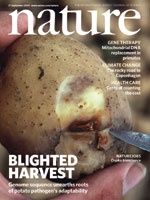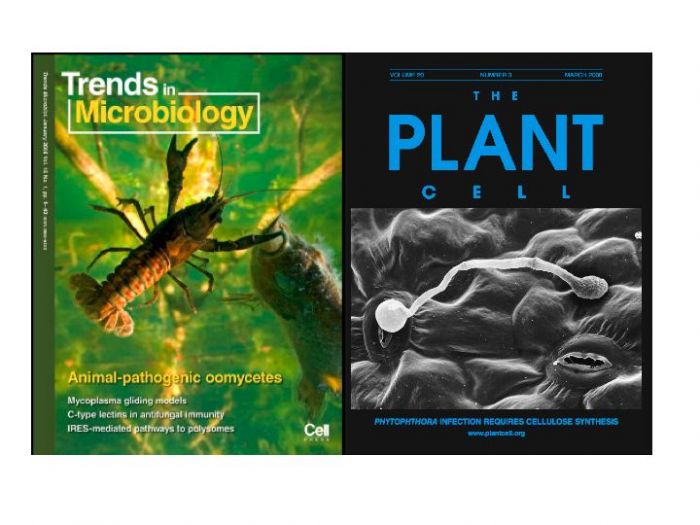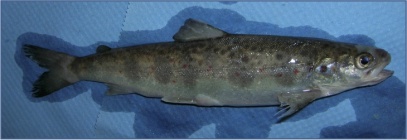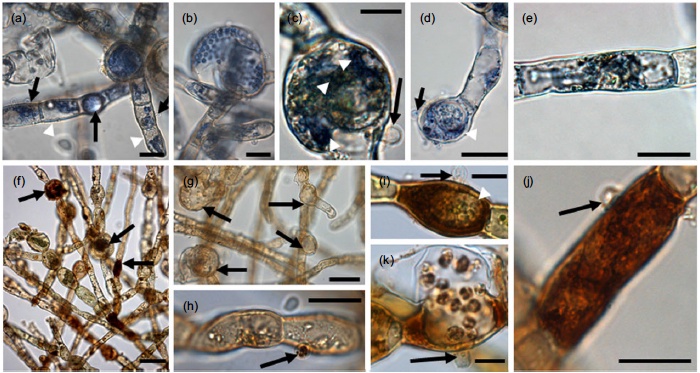
MSc (Wageningen, The Netherlands, 1993) PhD (Wageningen, The Netherlands, 2000)
Chair in Mycology
- Email Address
- p.vanwest@abdn.ac.uk
- Telephone Number
- +44 (0)1224 437327
- Office Address
Office 2:33, Lab 2:39
Aberdeen Oomycete Laboratory
College of Life Sciences and Medicine
Institute of Medical Sciences
Foresterhill
Aberdeen
AB25 2ZD- School/Department
- School of Medicine, Medical Sciences and Nutrition
Biography
Prof. Dr. Ir. Pieter van West is a past Royal Society University Research Fellow. He is Director of the International Centre for Aquaculture Research and Development (ICARD) at the University of Aberdeen, Board member of the Sustainable Aquaculture Innovation Centre (SAIC), Fellow of the Royal Society of Edinburgh and he was President of the British Mycological Society 2017-2018) .
His current research programme focuses on oomycete biology. Several economically and environmentally important oomycetes, or watermoulds, are studied at most disciplinary levels (taxonomy, ecology, epidemiology, biochemistry and cellular and molecular biology and especially host-microbe interactions). He is particularly interested in developing novel methods to control oomycete pathogens.
The animal pathogenic oomycetes under investigation are Saprolegnia parasitica, Saprolegnia australis, Saprolegnia diclina, Aphanomyces spp. and Halioticida spp.
The plant pathogenic species include mainly Phytophthora infestans and several Pythium spp. and the algal pathogenic species include Eurychasma dicksonii, Olpidiopsis spp., Anisolpidium spp. and Maulinia spp.
Memberships and Affiliations
Director of the International Centre for Aquaculture Research and Development (ICARD)
Fellow of the Royal Society of Edinburgh
Board member of the Sustainable Aquaculture Innovation Centre (SAIC)
Past President of the British Mycological Society
Editorial Board member of Fungal Biology
Editorial Board member of Fungal Biology Reviews
Research Overview
Fundamental molecular processes in Oomycete pathogens
The group of oomycete pathogens cause destructive diseases of thousands of (commercially important) plant species and fish. These so-called watermoulds have many fungus-like characteristics, but are not true-fungi. In fact, they are closely related to kelp and diatoms.
One particular oomycete, Phytophthora infestans, the causal agent of potato late blight, generates global yield losses estimated to exceed over £3 billion annually, making it one of the most important biotic constraints to global food production. It is probably the most destructive plant pathogen in human history, as it caused tremendous human suffering in the mid 1840's due to failed potato crops in Ireland and the UK.
One of the most destructive oomycete pathogens on fish is Saprolegnia parasitica. It is endemic to all fresh water habitats around the world and is partly responsible for the decline of natural populations of salmonids and other fresh water fish. Today, losses in the salmon aquaculture business in Scotland alone are estimated at several millions of pounds annually.

Despite their economic importance, little is known about the molecular mechanisms accounting for the success of Oomycetes as plant or fish pathogens, or the fundamental molecular processes underlying their development. My research program aspires to identify molecular characteristics that are essential for the development and pathogenesis of Phytophthora, Pythium and Saprolegnia species.
Work mainly focuses on the isolation and functional characterisation of genes encoding recognition molecules and stage-specific proteins to enable
- understanding and unravelling fundamental molecular processes in Oomycetes
- the detection of molecular targets for novel control strategies, possibly directed against a variety of Oomycete pathogens.

Current Research
1 Identification and functional characterisation of zoospore specific proteins from oomycetes via genomic, transcriptomic and proteomics approaches (Figure 1).

Figure 1. Zoospores are released from a sporangium of Saprolegnia parasitica (taken from van West, 2006)
2 Identification and functional characterisation of proteins from Saprolegnia parastica, a fish pathogen of salmonids and other fresh water fish (Figure 2), that are essential for development and pathogenicity.

Figure 2. Saprolegnia infection on pre-smolt salmon.
3 Investigating the mechanism of Phytophthora and Saprolegnia protein translocation into the host cells (Figure 3).

Figure 3 Oomycete effector translocation (Image taken from Wawra et al., 2012 Current Opinion in Microbiology doi:10.1016/j.mib.2012.10.008).
4 Research into oomycete-insect interactions

Figure 4 Saprolegnia infections of waterborne insects (Image taken from Sarowar et al. 2013 Fungal Biology 117: 752-763).
5 Research into oomycete-algae interactions.

Figure 5 Eurychasma infections in Ectocarpus (Image taken from Strittmatter et al., 2015, Plant Cell & Environment doi: 10.1111/pce.12533).
6 Discovering and describing novel oomycete species

Figure 6 Oospores of Pythium polare, a pathogen of moss from the arctic and antarctic regions (Image taken from Tojo et al. 2012, Fungal Biology doi:10.1016/j.funbio.2012.04.005).
Teaching Responsibilities
Eukaryotic Microbiology lectures in course BI25M5 (Microbes, Infection & Immunity)
Molecular Plant Pathology lectures in course AG3816 (Biology and Ecology of Plant Disease)
Page 2 of 3 Results 51 to 100 of 128
Erratum to Role of pathogen-derived cell wall carbohydrates and prostaglandin E2 in immune response and suppression of fish immunity by the oomycete Saprolegnia parasitica
Belmonte, R., Wang, T., Duncan, G. J., Skaar, I., Mélida, H., Bulone, V., van West, P., Secombes, C. J., Appleton, J. (ed.)Infection and Immunity, vol. 83, no. 1, pp. 454Contributions to Journals: Articles- [ONLINE] DOI: https://doi.org/10.1128/IAI.02821-14
- [ONLINE] View publication in Scopus
Disease Resistance In Brown Algae: Mechanisms and Heritability
Strittmatter, M., Gachon, C. M. M., Mueller, D. G., Tsirigoti, A., Wawra, S., Beckmann, M., Katsaros, C., van West, P., Kuepper, F. C.European journal of phycology, vol. 50, no. Supp 1, pp. 48-49Contributions to Journals: Abstracts- [ONLINE] DOI: https://doi.org/10.1080/09670262.2015.1069489
New record and phylogenetic affinities of the oomycete Olpidiopsis feldmanni infecting Asparagopsis sp. (Rhodophyta)
Fletcher, K., Zuljevic, A., Tsirigoti, A., Antolic, B., Katsaros, C. I., Nikolic, V., Van West, P., Kuepper, F. C.Diseases of Aquatic Organisms, vol. 117, no. 1, pp. 45-57Contributions to Journals: Articles- [ONLINE] DOI: https://doi.org/10.3354/dao02930
- [OPEN ACCESS] http://aura.abdn.ac.uk/bitstream/2164/5516/1/d117p045.pdf
The pathogens of brown algae Anisolpidium ectocarpii and Anisolpidium rosenvingei define a new class of marine anteriorly uniciliate oomycetes
Gachon, C. M. M., Fletcher, K. I., Badis, Y., van West, P., Mueller, D. G.European journal of phycology, vol. 50, no. sup 1, pp. 25-26Contributions to Journals: Abstracts- [ONLINE] DOI: https://doi.org/10.1080/09670262.2015.1069489
Fish Vaccine
Wawra, S., Van West, P., Secombes, C. J.Patents: Patents- [ONLINE] WO2014191759 (A1) - FISH VACCINE
Role of Pathogen-Derived Cell Wall Carbohydrates and Prostaglandin E2 in Immune Response and Suppression of Fish Immunity by the Oomycete Saprolegnia parasitica
Belmonte, R., Wang, T., Duncan, G. J., Skaar, I., Mélida, H., Bulone, V., van West, P., Secombes, C. J.Infection and Immunity, vol. 82, no. 11, pp. 4518-4529Contributions to Journals: Articles- [ONLINE] DOI: https://doi.org/10.1128/IAI.02196-14
Seaweed biodiversity in the south-western Antarctic Peninsula: surveying macroalgal community composition in the Adelaide Island/Marguerite Bay region over a 35-year time span
Mystikou, A., Peters, A. F., Asensi, A. O., Fletcher, K. I., Brickle, P., van West, P., Convey, P., Kuepper, F. C.Polar Biology, vol. 37, no. 11, pp. 1607-1619Contributions to Journals: ArticlesDeciphering microbial landscapes of fish eggs to mitigate emerging diseases
Liu, Y., de Bruijn, I., Jack, A. L., Drynan, K., van den Berg, A. H., Thoen, E., Sandoval-Sierra, V., Skaar, I., van West, P., Diéguez-Uribeondo, J., van der Voort, M., Mendes, R., Mazzola, M., Raaijmakers, J. M.The ISME Journal, vol. 8, no. 10, pp. 2002-2014Contributions to Journals: Articles- [ONLINE] DOI: https://doi.org/10.1038/ismej.2014.44
Infection strategies of pathogenic oomycetes in fish
Sarowar, M. N., Saraiva, M., Jessop, C. N., Lilje, O., Gleason, F. H., West, P. v.Freshwater Fungi: and Fungal-like Organisms. Jones, E. B. G., Hyde, K. D., Pang, K. (eds.). Walter de Gruyter, pp. 217-244, 28 pagesChapters in Books, Reports and Conference Proceedings: Chapters- [ONLINE] DOI: https://doi.org/10.1515/9783110333480.217
A putative serine protease, SpSsp1, from Saprolegnia parasitica is recognised by sera of rainbow trout, Oncorhynchus mykiss
Minor, K. L., Anderson, V. L., Davis, K. S., Van Den Berg, A. H., Christie, J. S., Loebach, L., Faruk, A. R., Wawra, S., Secombes, C. J., Van West, P.Fungal Biology, vol. 118, no. 7, pp. 630-639Contributions to Journals: ArticlesAnimal pathogenic Oomycetes
van West, P., Beakes, G. W.Fungal Biology, vol. 118, no. 7, pp. 525-526Contributions to Journals: Articles- [ONLINE] DOI: https://doi.org/10.1016/j.funbio.2014.05.004
- [ONLINE] View publication in Scopus
Reprint of: Saprolegnia strains isolated from river insects and amphipods are broad spectrum pathogens
Sarowar, M. N., van den Berg, A. H., McLaggan, D., Young, M. R., van West, P.Fungal Biology, vol. 118, no. 7, pp. 579-590Contributions to Journals: Articles- [ONLINE] DOI: https://doi.org/10.1016/j.funbio.2014.05.005
- [ONLINE] View publication in Scopus
Auto-aggregation in zoospores of Phytophthora infestans: the cooperative roles of bioconvection and chemotaxis
Savory, A. I. M., Grenville-Briggs, L. J., Wawra, S., van West, P., Davidson, F. A.Journal of the Royal Society Interface, vol. 11, no. 94, 20140017Contributions to Journals: Articles- [ONLINE] DOI: https://doi.org/10.1098/rsif.2014.0017
Global distribution of two fungal pathogens threatening endangered sea turtles
Sarmiento-Ramirez, J. M., Abella-Perez, E., Phillott, A. D., Sim, J., van West, P., Martin, M. P., Marco, A., Dieguez-Uribeondo, J.PloS ONE, vol. 9, no. 1, e85853Contributions to Journals: ArticlesParental transfer of the antimicrobial protein LBP/BPI protects Biomphalaria glabrata eggs against oomycete infections
Baron, O. L., van West, P., Industri, B., Ponchet, M., Dubreuil, G., Gourbal, B., Reichhart, J., Coustau, C.PLoS Pathogens, vol. 9, no. 12, e1003792Contributions to Journals: Articles- [ONLINE] DOI: https://doi.org/10.1371/journal.ppat.1003792
- [OPEN ACCESS] http://aura.abdn.ac.uk/bitstream/2164/3464/1/Parentla_transfer.pdf
Managing scientific diving operations in a remote location: the Canadian high Arctic
Sayer, M. D. J., Kuepper, F. C., van West, P., Wilson, C. M., Brown, H., Azzopardi, E.Diving and Hyperbaric Medicine, vol. 43, no. 4, pp. 239-243Contributions to Journals: ArticlesSaprolegnia strains isolated from river insects and amphipods are broad spectrum pathogens
Sarowar, M. N., van den Berg, A. H., McLaggan, D., Young, M. R., van West, P.Fungal Biology, vol. 117, no. 11-12, pp. 752-763Contributions to Journals: Articles- [ONLINE] DOI: https://doi.org/10.1016/j.funbio.2013.09.002
The impact of the water moulds Saprolegnia diclina and Saprolegnia parasitica on natural ecosystems and the aquaculture industry
Van Den Berg, A. H., McLaggan, D., Dieguez-Uribeond, J., van West, P.Fungal Biology Reviews, vol. 27, no. 2, pp. 33-42Contributions to Journals: Literature Reviews- [ONLINE] DOI: https://doi.org/10.1016/j.fbr.2013.05.001
Distinctive expansion of potential virulence genes in the genome of the oomycete fish pathogen Saprolegnia parasitica
Jiang, R. H. Y., de Bruijn, I., Haas, B. J., Belmonte, R., Löbach, L., Christie, J., van den Ackerveken, G., Bottin, A., Bulone, V., Díaz-Moreno, S. M., Dumas, B., Fan, L., Gaulin, E., Govers, F., Grenville-Briggs, L. J., Horner, N. R., Levin, J. Z., Mammella, M., Meijer, H. J. G., Morris, P., Nusbaum, C., Oome, S., Phillips, A. J., van Rooyen, D., Rzeszutek, E., Saraiva, M., Secombes, C. J., Seidl, M. F., Snel, B., Stassen, J. H. M., Sykes, S., Tripathy, S., van den Berg, H., Vega-Arreguin, J. C., Wawra, S., Young, S. K., Zeng, Q., Dieguez-Uribeondo, J., Russ, C., Tyler, B. M., van West, P.PLoS Genetics, vol. 9, no. 6, e1003272Contributions to Journals: ArticlesIn Vitro Trans location Experiments with RxLR-Reporter Fusion Proteins of Avr1b from Phytophthora sojae and AVR3a from Phytophthora infestans Fail to Demonstrate Specific Autonomous Uptake in Plant and Animal Cells
Wawra, S., Djamei, A., Albert, I., Nuernberger, T., Kahmann, R., van West, P.Molecular Plant-Microbe Interactions, vol. 26, no. 5, pp. 528-536Contributions to Journals: Articles- [ONLINE] DOI: https://doi.org/10.1094/MPMI-08-12-0200-R
A family of small tyrosine rich proteins is essential for oogonial and oospore cell wall development of the mycoparasitic oomycete Pythium oligandrum
Grenville-Briggs, L. J., Horner, N. R., Phillips, A. J., Beakes, G. W., Van West, P.Fungal Biology, vol. 117, no. 3, pp. 163-172Contributions to Journals: Articles- [ONLINE] DOI: https://doi.org/10.1016/j.funbio.2013.01.001
- [ONLINE] View publication in Scopus
Secretion, delivery and function of oomycete effector proteins
Wawra, S., Belmonte, R., Löbach, L., Saraiva, M., Willems, A., van West, P.Current Opinion in Microbiology, vol. 15, no. 6, pp. 685-691Contributions to Journals: Articles- [ONLINE] DOI: https://doi.org/10.1016/j.mib.2012.10.008
Avirulence protein 3a (AVR3a) from the potato pathogen Phytophthora infestans forms homodimers through its predicted translocation region and does not specifically bind phospholipids
Wawra, S., Agacan, M., Boddey, J. A., Davidson, I., Gachon, C. M. M., Zanda, M., Grouffaud, S., Whisson, S. C., Birch, P. R. J., Porter, A. J., van West, P.The Journal of Biological Chemistry, vol. 287, no. 45, pp. 38101-38109Contributions to Journals: Articles- [ONLINE] DOI: https://doi.org/10.1074/jbc.M112.395129
Immune Gene Expression in Trout Cell Lines Infected with the Fish Pathogenic Oomycete Saprolegnia Parasitica
Bruijn, I. d., Belmonte, R., Anderson, V. L., Saraiva, M., Wang, T., West, P. v., Secombes, C. J.Developmental and Comparative Immunology, vol. 38, no. 1, pp. 44-54Contributions to Journals: Articles- [ONLINE] DOI: https://doi.org/10.1016/j.dci.2012.03.018
Pythium polare, a new heterothallic oomycete causing brown discolouration of Sanionia uncinata in the Arctic and Antarctic
Tojo, M., Van West, P., Hoshino, T., Kida, K., Fujii, H., Hakoda, A., Kawaguchi, Y., Mühlhauser, H. A., Van Den Berg, A. H., Küpper, F. C., Herrero, M. L., Klemsdal, S. S., Tronsmo, A. M., Kanda, H.Fungal Biology, vol. 116, no. 7, pp. 756-768Contributions to Journals: Articles- [ONLINE] DOI: https://doi.org/10.1016/j.funbio.2012.04.005
- [ONLINE] View publication in Scopus
Host-targeting protein 1 (SpHtp1) from the oomycete Saprolegnia parasitica translocates specifically into fish cells in a tyrosine-O-sulphate-dependent manner
Wawra, S. W., Bain, J. M., Durward, E., de Bruijn, I., Minor, K., Matena, A., Lobach, L., Whisson, S., Bayer, P., Porter, A. J. R., Birch, P., Secombes, C. J., Van West, P.PNAS, vol. 109, no. 6, pp. 2096-2101Contributions to Journals: Articles- [ONLINE] DOI: https://doi.org/10.1073/pnas.1113775109
Evidence for involvement of Dicer-like, Argonaute and histone deacetylase proteins in gene silencing in Phytophthora infestans
Vetukuri, R. R., Avrova, A. O., Grenville-Briggs, L. J., van West, P., Soderbom, F., Savenkov, E. I., Whisson, S. C., Dixelius, C.Molecular Plant Pathology, vol. 12, no. 8, pp. 772-785Contributions to Journals: Articles- [ONLINE] DOI: https://doi.org/10.1111/j.1364-3703.2011.00710.x
A molecular insight into algal-oomycete warfare: cDNA analysis of Ectocarpus siliculosus infected with the basal oomycete Eurychasma dicksonii
Grenville-Briggs, L., Gachon, C. M. M., Strittmatter, M., Sterck, L., Kuepper, F. C., van West, P.PloS ONE, vol. 6, no. 9, e24500Contributions to Journals: Articles- [ONLINE] DOI: https://doi.org/10.1371/journal.pone.0024500
- [OPEN ACCESS] http://aura.abdn.ac.uk/bitstream/2164/2260/1/Plos_one_Eurychasma.pdf
Presence/absence, differential expression and sequence polymorphisms between PiAVR2 and PiAVR2-like in Phytophthora infestans determine virulence on R2 plants
Gilroy, E. M., Breen, S., Whisson, S. C., Squires, J., Hein, I., Kaczmarek, M., Turnbull, D., Boevink, P. C., Lokossou, A., Cano, L. M., Morales, J., Avrova, A. O., Pritchard, L., Randall, E., Lees, A., Govers, F., van West, P., Kamoun, S., Vleeshouwers, V. G. A. A., Cooke, D. E. L., Birch, P. R. J.New Phytologist, vol. 191, no. 3, pp. 736-776Contributions to Journals: Articles- [ONLINE] DOI: https://doi.org/10.1111/j.1469-8137.2011.03736.x
The putative RxLR effector protein SpHtp1 from the fish pathogenic oomycete Saprolegnia parasitica is translocated into fish cells
van West, P., de Bruijn, I., Minor, K. L., Phillips, A. J., Robertson, E. J., Wawra, S., Bain, J., Anderson, V. L., Secombes, C. J.FEMS Microbiology Letters, vol. 310, no. 2, pp. 127-137Contributions to Journals: Articles- [ONLINE] DOI: https://doi.org/10.1111/j.1574-6968.2010.02055.x
YbdG in Escherichia coli is a threshold-setting mechanosensitive channel with MscM activity
Schumann, U., Edwards, M. D., Rasmussen, T., Bartlett, W., van West, P., Booth, I. R.PNAS, vol. 107, no. 28, pp. 12664-12669Contributions to Journals: Articles- [ONLINE] DOI: https://doi.org/10.1073/pnas.1001405107
Towards an understanding on how RxLR-effector proteins are translocated from oomycetes into host cells
Grouffaud, S., Whisson, S., Birch, P., van West, P.Fungal Biology Reviews, vol. 24, no. 1-2, pp. 27-36Contributions to Journals: Literature Reviews- [ONLINE] DOI: https://doi.org/10.1016/j.fbr.2010.01.002
Saprolegnia and other Oomycetes
Bruno, D., van West, P., Beakes, G.Fish Diseases and Disorders: Viral, Bacterial and Fungal Infections. Bruno, D. W., Woo, P. T. K. (eds.). 2nd edition. CABI International, pp. 669-720Chapters in Books, Reports and Conference Proceedings: ChaptersGenome sequence of the necrotrophic plant pathogen Pythium ultimum reveals original pathogenicity mechanisms and effector repertoire
Lévesque, C. A., Brouwer, H., Cano, L., Hamilton, J. P., Holt, C., Huitema, E., Raffaele, S., Robideau, G. P., Thines, M., Win, J., Zerillo, M. M., Beakes, G. W., Boore, J. L., Busam, D., Dumas, B., Ferriera, S., Fuerstenberg, S. I., Gachon, C. M. M., Gaulin, E., Govers, F., Grenville-Briggs, L., Horner, N., Hostetler, J., Jiang, R. H. Y., Johnson, J., Krajaejun, T., Lin, H., Meijer, H. J. G., Moore, B., Morris, P., Phuntmart, V., Puiu, D., Shetty, J., Stajich, J. E., Tripathy, S., Wawra, S., van West, P., Whitty, B. R., Coutinho, P. M., Henrissat, B., Martin, F., Thomas, P. D., Tyler, B. M., De Vries, R. P., Kamoun, S., Yandell, M., Tisserat, N., Buell, C. R.Genome Biology, vol. 11, no. 7, pp. R73Contributions to Journals: Articles- [ONLINE] DOI: https://doi.org/10.1186/gb-2010-11-7-r73
Identification of appressorial and mycelial cell wall proteins and a survey of the membrane proteome of Phytophthora infestans
Grenville-Briggs, L. J., Avrova, A., Hay, R., Bruce, C., Whisson, S., Van West, P.Fungal Biology, vol. 114, pp. 702-723Contributions to Journals: Articles- [ONLINE] DOI: https://doi.org/10.1016/j.funbio.2010.06.003
Seaweed and oomycete benthic diversity in the Canadian Marine Arctic: managing scientific diving operations in a remote location
Sayer, M., Küpper, F., van West, P., Wilson, C., Brown, H., Azzopardi, E.Contributions to Conferences: PapersSeaweed and oomycete diversity in the Canadian Marine Arctic
Küpper, F. C., van West, P., Sayer, M. D. J., Kawai, H., Brown, H., Azzopardi, E., Dargent, O., Strittmatter, M., Wilce, R. T.Ocean Explorer, vol. 35, no. Summer, pp. 12-13Contributions to Journals: ArticlesGenome sequence and analysis of the Irish potato famine pathogen Phytophthora infestans
Haas, B. J., Kamoun, S., Zody, M. C., Jiang, R. H. Y., Handsaker, R. E., Cano, L. M., Grabherr, M., Kodira, C. D., Raffaele, S., Torto-Alalibo, T., Bozkurt, T. O., Ah-Fong, A. M. V., Alvarado, L., Anderson, V., Armstrong, M. R., Avrova, A., Baxter, L., Beynon, J., Boevink, P. C., Bollmann, S. R., Bos, J. I. B., Bulone, V., Cai, G., Cakir, C., Carrington, J. C., Chawner, M., Conti, L., Costanzo, S., Ewan, R., Fahlgren, N., Fischbach, M. A., Fugelstad, J., Gilroy, E. M., Gnerre, S., Green, P. J., Grenville-Briggs, L., Griffith, J., Grünwald, N. J., Horn, K., Horner, N. R., Hu, C., Huitema, E., Jeong, D., Jones, A. M. E., Jones, J. D. G., Jones, R. W., Karlsson, E. K., Kunjeti, S. G., Lamour, K., Liu, Z., Ma, L., Maclean, D., Chibucos, M. C., McDonald, H., McWalters, J., Meijer, H. J. G., Morgan, W., Morris, P. F., Munro, C. A., O'Neill, K., Ospina-Giraldo, M., Pinzón, A., Pritchard, L., Ramsahoye, B., Ren, Q., Restrepo, S., Roy, S., Sadanandom, A., Savidor, A., Schornack, S., Schwartz, D. C., Schumann, U., Schwessinger, B., Seyer, L., Sharpe, T., Silvar, C., Song, J., Studholme, D. J., Sykes, S., Thines, M., van de Vondervoort, P. J. I., Phuntumart, V., Wawra, S. W., Weide, R., Win, J., Young, C., Zhou, S., Fry, W., Meyers, B. C., Van West, P., Ristaino, J., Govers, F., Birch, P. R. J., Whisson, S. C., Judelson, H. S., Nusbaum, C.Nature, vol. 461, no. 7262, pp. 393-398Contributions to Journals: Articles- [ONLINE] DOI: https://doi.org/10.1038/nature08358
Mechanisms and Application of Gene Silencing in Oomycetes
Whisson, S. C., Avrova, A. O., Grenville-Briggs, L. J., van West, P.Oomycete Genetics and Genomics: Diversity, Interactions and Research Tools. Lamour, K., Kamoun, S. (eds.). Wiley-Blackwell, pp. 493-516, 24 pagesChapters in Books, Reports and Conference Proceedings: Chapters- [ONLINE] DOI: https://doi.org/10.1002/9780470475898.ch25
Saprolegnia: Fish Interactions
Robertson, E. J., Anderson, V. L., Secombes, C. J., Dieguez-Uribeondo, J., van West, P.Oomycete Genetics and Genomics: Diversity, Interactions and Research Tools. Lamour, K., Kamoun, S. (eds.). Wiley-Blackwell, pp. 407-424, 18 pagesChapters in Books, Reports and Conference Proceedings: Chapters- [ONLINE] DOI: https://doi.org/10.1002/9780470475898.ch20
- [ONLINE] View publication in Scopus
Paenibacillus polymyxa antagonizes oomycete plant pathogens Phytophthora palmivora and Pythium aphanidermatum
Timmusk, S., Van West, P., Gow, N. A. R., Huffstutler, R. P.Journal of Applied Microbiology, vol. 106, no. 5, pp. 1473-1481Contributions to Journals: Articles- [ONLINE] DOI: https://doi.org/10.1111/j.1365-2672.2009.04123.x
Towards understanding the virulence functions of RXLR effectors of the oomycete plant pathogen Phytophthora infestans
Birch, P. R. J., Armstrong, M., Bos, J., Boevink, P., Gilroy, E. M., Taylor, R. M., Wawra, S., Pritchard, L., Conti, L., Ewan, R., Whisson, S. C., van West, P., Sadanandom, A., Kamoun, S.Journal of Experimental Botany, vol. 60, no. 4, pp. 1133-1140Contributions to Journals: Literature Reviews- [ONLINE] DOI: https://doi.org/10.1093/jxb/ern353
Plasmodium falciparum and Hyaloperonospora parasitica effector translocation motifs are functional in Phytophthora infestans
Grouffaud, S., van West, P., Avrova, A. O., Birch, P. R. J., Whisson, S. C.Microbiology , vol. 154, no. 12, pp. 3743-3751Contributions to Journals: Articles- [ONLINE] DOI: https://doi.org/10.1099/mic.0.2008/021964-0
A novel Phytophthora infestans haustorium-specific membrane protein is required for infection of potato
Avrova, A. O., Boevink, P. C., Young, V., Grenville-Briggs, L. J., van West, P., Birch, P. R. J., Whisson, S. C.Cellular Microbiology, vol. 10, no. 11, pp. 2271-2284Contributions to Journals: Articles- [ONLINE] DOI: https://doi.org/10.1111/j.1462-5822.2008.01206.x
A putative DEAD-box RNA-helicase is required for normal zoospore development in the late blight pathogen Phytophthora infestans
Walker, C. A., Koppe, M., Grenville-Briggs, L. J., Avrova, A. O., Horner, N. R., McKinnon, A. D., Whisson, S. C., Birch, P. R. J., van West, P.Fungal Genetics and Biology, vol. 45, no. 6, pp. 954-962Contributions to Journals: Articles- [ONLINE] DOI: https://doi.org/10.1016/j.fgb.2008.03.004
Internuclear gene silencing in Phytophthora infestans is established through chromatin remodelling
van West, P., Shepherd, S. J., Walker, C. A., Li, S., Appiah, A. A., Grenville-Briggs, L. J., Govers, F., Gow, N. A. R.Microbiology , vol. 154, no. 5, pp. 1482-1490Contributions to Journals: Articles- [ONLINE] DOI: https://doi.org/10.1099/mic.0.2007/015545-0
Gene expression profiling during asexual development of the late blight pathogen Phytophthora infestans reveals a highly dynamic transcriptome
Judelson, H. S., Ah-Fong, A. M. V., Aux, G., Avrova, A. O., Bruce, C., Calkir, C., da Cunha, L., Grenville-Briggs, L., Latijnhouwers, M., Ligterink, W., Meijer, H. J. G., Roberts, S., Thurber, C. S., Whisson, S. C., Birch, P. R. J., Govers, F., Kamoun, S., van West, P., Windass, J.Molecular Plant-Microbe Interactions, vol. 21, no. 4, pp. 433-447Contributions to Journals: Articles- [ONLINE] DOI: https://doi.org/10.1094/MPMI-21-4-0433
Cellulose synthesis in Phytophthora infestans is required for normal appressorium formation and successful infection of potato
Grenville-Briggs, L. J., Anderson, V. L., Fugelstad, J., Avrova, A. O., Bouzenzana, J., Williams, A., Wawra, S., Whisson, S. C., Birch, P. R. J., Bulone, V., van West, P.The Plant Cell, vol. 20, no. 3, pp. 720-738Contributions to Journals: Articles- [ONLINE] DOI: https://doi.org/10.1105/tpc.107.052043
Exploitation of fungi: Symposium of the British mycological society held at the University of Manchester September 2005
Robson, G. D. (ed.), van West, P. (ed.), Gadd, G. M. (ed.)Cambridge University Press. 345 pagesBooks and Reports: Books- [ONLINE] DOI: https://doi.org/10.1017/CBO9780511902451
- [ONLINE] View publication in Scopus
Preface: Exploitation of Fungi
Robson, G. D., van West, P., Gadd, G. M.Chapters in Books, Reports and Conference Proceedings: Forewords and Postscripts- [ONLINE] DOI: https://doi.org/10.1017/CBO9780511902451.001
- [ONLINE] View publication in Scopus
